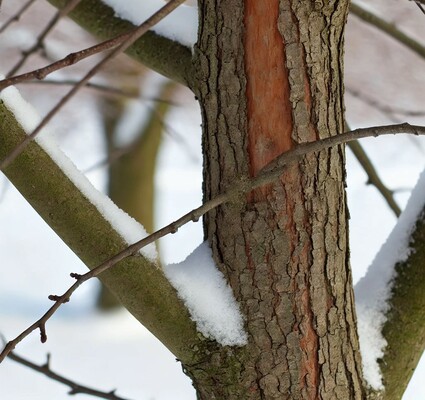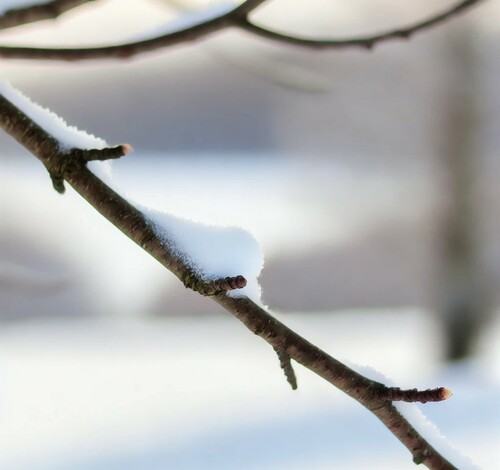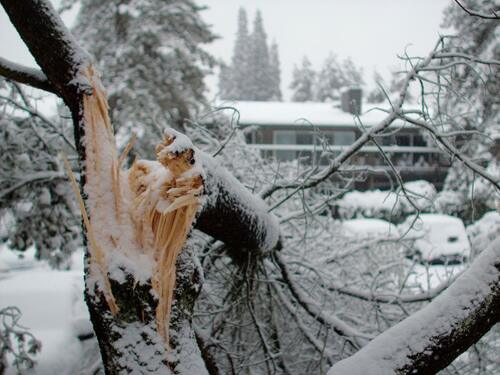Caring for Trees in the Winter

Introduction
Winter can be a challenging season for trees, with harsh weather conditions such as storms, ice, and fluctuating temperatures taking a toll. Even trees native to colder regions in North America can experience stress during winter, particularly those that are exposed and isolated in residential areas. While some winter stress is inevitable, there are several steps you can take to minimize the damage and help your trees survive the cold months.
Understanding and Mitigating Cold Stress

A Close-up of a Tree Branch Covered in Snow
Frost Cracking and Temperature Fluctuations
Situation: Cold stress manifests in various forms, and one of the most common is frost cracking. This occurs due to the rapid variations between daytime and nighttime temperatures, which can create stress between the outer and inner wood, leading to cracks. These cracks, often referred to as "frost cracking" or "southwest injury," typically occur on the side of the tree that receives the most sunlight.
Solution: Unfortunately, preventing frost cracking is difficult. However, most trees can naturally repair themselves, although the cracked area remains vulnerable and may crack again in the same spot, potentially causing significant damage. For young trees, palms, and other tropical species, wrapping the bark as part of your fall maintenance routine can provide added protection.
Sudden Early Frost on Late Growth
Situation: Late-season growth is particularly susceptible to cold stress, as it lacks the established strength to withstand freezing temperatures. When ice crystals form on the new tips of branches, the cell walls rupture, leading to die-off in the following season.
Solution: To avoid this, refrain from pruning until your tree has gone dormant in the fall. Pruning too early encourages new growth, which increases the risk of frost damage. Additionally, avoid using fertilizers with high amounts of quick-release nitrogen, as they can promote unwanted late growth.
Combating Winter Drought
Moisture Loss in Evergreens
Situation: Winter drought occurs when a tree loses more water than it can absorb from the frozen ground, leading to drying out. This is particularly problematic for evergreens, especially in early spring when the ground remains frozen while the sun warms the rest of the tree. Windy conditions exacerbate this issue by increasing moisture loss.
Solution: To combat winter drought, apply a thick layer of mulch around the bases of your trees before winter arrives. Mulch acts as a temperature barrier, protecting the roots from extreme cold and reducing moisture loss and runoff. Additionally, ensure that your trees are well watered in the late fall before the ground freezes to help them retain moisture throughout the winter.
Preventing Branch Breakage

A Snow-Damaged Tree Branch After A Severe Winter Storm
Vulnerability to Wind and Ice Damage
Situation: Branches become more brittle and susceptible to breakage during the winter, especially on deciduous trees. The accumulation of ice and snow can further stress both deciduous trees and evergreens, leading to broken branches and damaged trees.
Solution: Proper fall tree maintenance is crucial for minimizing branch breakage. Pruning weak and vulnerable branches before winter can make the entire tree more resilient. Removing one limb of a pair sharing a deep "V" crotch is another effective method to reduce the risk of branch breakage. For expert assistance, consider reaching out to Arborist Now, the premier tree care experts in the greater San Francisco Bay area.
Rodents

A Mouse Nestled at A Tree Base in Winter Snow
Rodent Damage to Tree Bark
Situation: Rodents, such as mice and rabbits, often target trees during the winter as they forage for food. These animals can chew on the bark, leading to girdling, which can severely damage or even kill a tree. Squirrels may also pose a problem, although they are less common offenders.
Solution: To protect your trees from rodents, leave a space between the mulch and the tree trunk, as this discourages mice from nesting. Regularly check for signs of rodent damage, and consider setting out bait if mice are a problem, but be sure to follow the instructions carefully. For rabbits, a wire mesh enclosure around the tree base can provide effective protection. Commercial paint-on repellents are also available to deter these pests.
Winter Preparation Checklist
- Choose Native Species: When planting new trees, select species that are native to your area's hardiness zone. Trees from even slightly milder zones may struggle to survive your region's winter conditions.
- Maintain Year-round Tree Care: Healthy, well-maintained trees are better equipped to withstand winter stress. Regular inspections and care throughout the year are essential.
- Inspect and Treat Winter Damage: Conduct a thorough inspection of your trees at the beginning of spring and address any damage that has occurred over the winter.
- Prune at the Right Time: Only prune trees after they have entered dormancy to avoid encouraging new growth that could be damaged by frost.
- Apply Fall Fertilizer: Use a fertilizer in the fall that promotes root growth rather than leaf growth to prepare your trees for winter.
- Mulch for Protection: Spread a layer of mulch around the bases of your trees to moderate temperature fluctuations and reduce moisture loss. Be sure to leave a gap between the mulch and the tree trunk to prevent rodent damage.
- Monitor for Rodents: Check your trees periodically during the winter for signs of rodent activity and take appropriate measures, such as using bait, enclosures, or repellents.
Take the Next Step for Your Tree Care
If you're ready to take the next step in protecting your trees this winter, Arborist Now is here to help. Our expert team in San Francisco is available year-round to provide the best tree care services. Contact us today or visit our website to learn more about how we can help your trees and landscape thrive even in the harshest winter conditions.
Originally posted on November 23, 2020.





